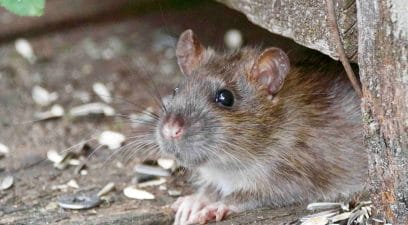Rats In Drains
Getting rid of rats in drains can be a difficult task because they are notoriously hardy and resourceful. It is important to take preventative measures before the infestation becomes worse. Rats will find any opening, no matter how small. They will create nests inside walls and behind pipes for safety from natural predators like owls and hawks.
The biggest concern with rat-infested drains is that faeces and urine will build up over time leading to odour problems. This can become a potential health hazard when it comes to mould growth caused by moisture in your home’s plumbing system.
These pests love to eat food scraps that get washed down your drain or flushed down your toilet. The more you feed them, the more they will breed, so it is best to take precautions before they get out of hand! Rats may not seem too scary at first glance, but rats carry diseases such as salmonella and parasites which can make humans sick if ingested. Rat droppings contain bacteria that cause a disease called leptospirosis which affects humans and animals alike; rats also chew through wires causing power cuts.
The Rats Habitat
Rats are in the drain system all the time. They use it to get around, a source of food and a place to live. They have everything they need in there. However, it’s cold and damp with basic food, so they will always try to break out the drain system, too.
Rats living in the drains is a common problem for both commercial and residential property owners. These rodents do not discriminate against what they will nibble on, so their presence can be a nuisance. Rats are often drawn to properties by food sources such as rubbish, pet food bowls, fruit trees, and any other edibles that may be sitting out in the open. This blog post will give you some tips on how to get rid of rats from your home or business!
In addition to this blog post being informative about rat control methods, it also includes information on preventing them from coming back into your space!
How To Stop Rats In Drains
Make sure all of the pipe openings are sealed off at least 6″ inside the wall or under floor level. This includes pipes for sinks, tubs, showers, toilets and any other water-carrying pipes that aren’t used frequently. If they’re not sealed properly rodents can find a way inside and start nesting. They also like to chew on things so seal any wires or cables that go through the walls as well.
Use a drain valve. A drain valve is a type of pipe fitting that controls the flow of water. Drain valves are used in residential and commercial plumbing systems to control the flow rate and direction of wastewater, as well as to prevent sewage backups. They can be installed at the end of a drain line or inside a fixture such as a sink or a toilet.
A drain valve (or drain gate) can be used to stop rats from getting into parts of the drain system. It can be used as a quick fix whilst you are waiting for repairs to happen. It can also be used as a permanent feature if you have a weak point or vulnerable area of drainage. This blog is designed to inform you about the drain valve if you are going to have one fitted.
Rats In Your Drainpipes?
Rats may not be the most pleasant of creatures to come across, but they’re just trying to survive. They can’t help it if their habitat is your drainpipe! Luckily for you, we’ve already explored why rats live in drains and how an infestation happens.
Check out our other blog posts on this topic for more information about what’s going on with these little creatures. Rats in drains may seem like just a nuisance, but they can also be hazardous to your health. If you have a rat infestation and need some help then you can contact us, as it is not an infestation you want to be left too long.
We are members of the BPCA which demonstrates our professionalism. Get in touch today
